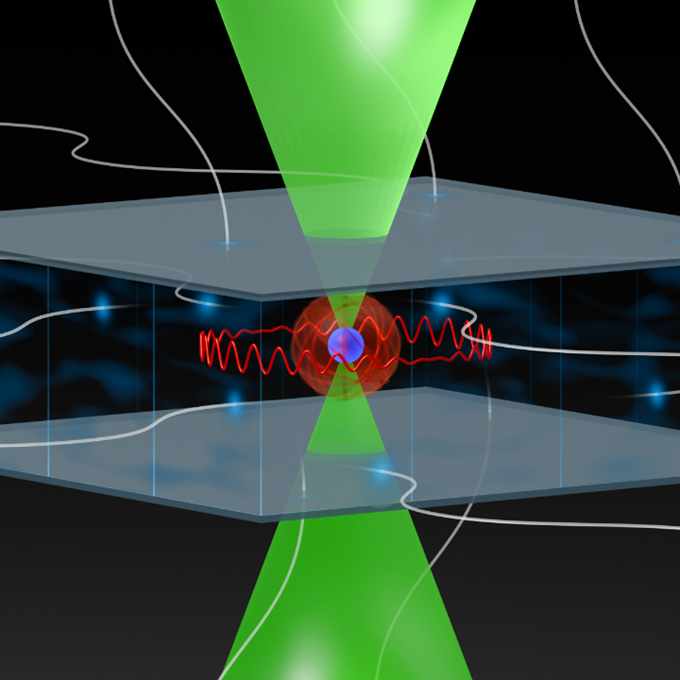Reviewed by Lexie CornerMay 9 2024
A group of researchers from the 5th Institute of Physics at the University of Stuttgart is making significant strides in quantum simulation and quantum computing based on Rydberg atoms. Their study was published in the journal Physical Review X.
Illustration of a circular strontium Rydberg atom trapped in optical tweezers. Image Credit: University of Stuttgart, Aaron Götzelmann
The use of neutral atoms in quantum computing and quantum simulation technologies is hampered by the short lifetime of Rydberg atoms, the building blocks of quantum computing, but circular Rydberg states offer a possible remedy.
Using a variety of optical tweezers, the research team has created and successfully captured circular Rydberg atoms of an alkaline-earth metal for the first time.
This is exciting because they are particularly stable and can extend the lifetime of a quantum bit enormously. They, therefore, have great potential for the development of more powerful quantum simulators.
Dr. Florian Meinert, Project In-charge and Head, Junior Research Group, 5th Institute of Physics
The Significance of Circular Rydberg Atoms
A circular Rydberg atom is a type of Rydberg atom in which the excited electron circles the atomic nucleus. These atoms are more stable and have a longer lifetime than other Rydberg states.
They are, hence, interesting candidates for application as qubits. Long recognized as the basis for investigations that won the Nobel Prize, circular Rydberg states reveal the quantum aspect of light-matter interaction. Their potential for quantum computing has recently become increasingly discussed.
Promising: Strontium, an Alkaline-Earth Metal
Since strontium offers special capabilities, it was chosen to produce the Rydberg atom. Strontium is an alkaline-earth metal with two optically active electrons. The second electron orbiting the atomic nucleus can be employed for quantum operations that are already known from studies on ion quantum computers after it is created in the circular Rydberg state.
The scientists produced extremely high-energy circular states of a strontium isotope at ambient temperature, demonstrating an incredibly long lifespan of up to 2.55 milliseconds.
Utilizing the unique characteristics of a cavity that absorbs blackbody background radiation, they were able to force the sensitive Rydberg electron into other energetically adjacent Rydberg levels. The circular states would not be able to endure for very long without this shielding.
They also owe their longer lifetime to their maximum angular momentum, which protects them from decay. This means that the quantum bits are more stable and, therefore, less susceptible to errors and external interference.
Christian Hölzl, Ph.D. Student, 5th Institute of Physics
Quantum Bits Under Control
A significant component of the research was the exact control and manipulation of a microwave quantum bit encoded in circular states. Thanks to this so-called coherent control, the scientists were able to move the qubit between states using microwave pulses without erasing its quantum information.
They could accurately ascertain the quantum bit's lifetime and learned crucial information about its stability at room temperature. For quantum operations to be precise and dependable, effective, coherent control is essential.
A Wide Range of Applications
There are several opportunities for executing quantum processes and, in particular, quantum simulations with circular Rydberg atoms.
Tilman Pfau, Professor and Director of the 5th Institute of Physics, said, “Their versatility makes them attractive for a wide range of applications.”
Pfau is also a director at the supraregional Carl Zeiss Foundation Center for Quantum Photonics, Jena, Stuttgart, Ulm (CZS Center QPhoton).
Circular Rydberg atoms offer opportunities for a scalable design that could be useful for constructing massive quantum bit systems based on neutral atoms. They can be precisely manipulated and trapped in optical tweezers or other traps.
Journal Reference:
Hölzl, C., et al. (2024) Long-Lived Circular Rydberg Qubits of Alkaline-Earth Atoms in Optical Tweezers. Physical Review. X. doi.org/10.1103/physrevx.14.021024.